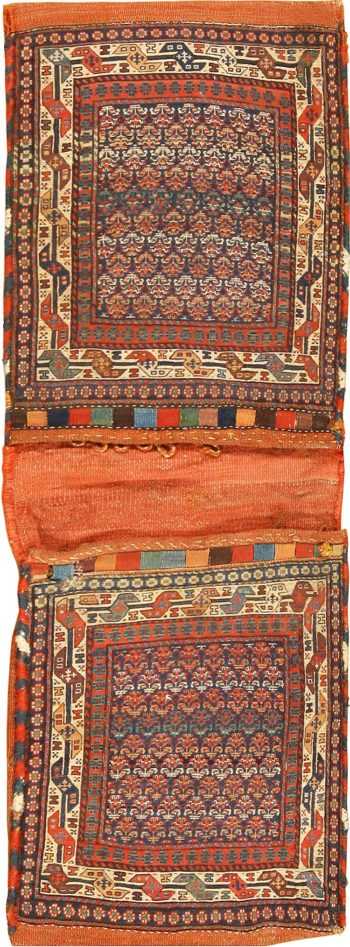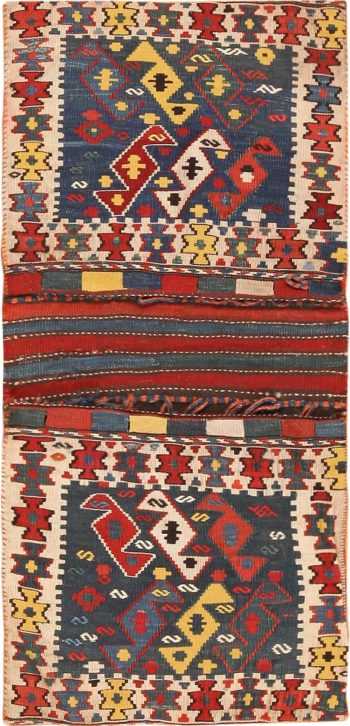Shasavan Shasevan Rugs
View our current selection of tribal antique Shahsavan rugs below:
Ivory Antique Square Tribal Caucasian Shahsavan Jajim 49933
$16,000.00Size: 6 ft x 6 ft 5 in (1.83 m x 1.96 m)Antique Collectible Persian Shahsavan Bag 49153
$6,900.00Size: 1 ft 10 in x 5 ft (0.56 m x 1.52 m)Antique Tribal Caucasian Shahsavan Bag 70283
$1,650.00Size: 1 ft 9 in x 3 ft 9 in (0.53 m x 1.14 m)
Learn More About Tribal Shahsavan Rugs
Shahsavan Rugs – Highly unusual and exciting, antique Shahsavan or Shahsevan area rugs and carpets have only recently been recognized as a distinct style of Persian rug. Uniquely, Shahsavan rugs and carpets were woven in an area of Persia known as the Transcaucasia – located today in extreme Northwest Iran. Because of the distinct cultural influences of this unique geographic region, Shahsavan carpets tend to have more in common with tribal Caucasian rugs than more traditional Persian rugs.
Related to the Kurdish rugs that were also woven in the Transcaucasia region, Shahsavan rugs have a strongly tribal flavor with highly abstract, geometric designs and rich colors. This also makes Shahsavan rugs a close aesthetic cousin of the Caucasian carpets that were also historically woven in this general area.
Shahsavan rugs are sometimes distinguished by certain shades of lavender or deep pink and salmon tones, in conjunction with soft blues; these light colors are atypical in other regional styles. The Shahsavan tribes were originally transported and resettled in the Northwest of Iran from their native homeland in Central Asia by the Persian kings of the seventeenth century. This important historical development helps to explain the close ties between the Shahsavan style and similar styles developed by the Turkomans and other Central Asian tribes. A unique style of antique Persian rug, Shahsavan rugs and carpets are rich in cultural significance as well as in beauty.
History Of Antique Shahsavan Rugs
Replete with vibrant colors and striking geometric patterns, Shahsavan rugs and textiles are beautiful and distinctive. The Shahsavan tribe is the source for these memorable designs. This tribe brings together rug weaving traditions from diverse backgrounds, including Armenian, Turkish, and Persian. The result is simply breath-taking.
The nomadic Shahsavan tribe came together at the behest of Shah Abbas Savafid (1587-1629), residing mainly in the mountainous area of northeastern Persia. Members of this tribe came from a number of smaller tribes with diverse backgrounds that show up in their rug designs.
According to historians, Shah Abbas formed the Shahvasan tribe to secure the western borders against rogue Turkish groups. To secure the tribe’s loyalty, he provided pasturage for their flocks of sheep. Their name, “Shahsavan”, means “those who love the Shah”.
What makes the Shahsavan design work distinctive? It’s highly geometric usually with a rectilinear medallion aligned in the center of the field, either horizontally or vertically. Each center medallion is surrounded by smaller motifs, often improvised by the weaver. The exception is found in runners, where most often the weaver uses an all over pattern instead of a medallion. With the weaving of antique rugs in bigger sizes, the Shahsavan weavers will use different designs including the boteh pattern, a Turkish Memling gul, a stepped hook center, or small animal design figures.
There are distinct similarities between the designs of the Shahsavan rugs and those that of the antique Caucasian rugs. Because of these similarities, some rug collectors refer to the Shahsavan as southern Caucasian designs, which is not entirely accurate. The Shahsavan textiles don’t adhere to design styles from a specific town or region as the Caucasus designs do.
Shahsavan rug weavers usually produce small area rugs and flat woven kilims. The flat weave rugs tend to be the most numerous due to the nomadic life of the weavers.



